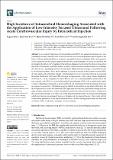High Incidence of Intracerebral Hemorrhaging Associated with the Application of Low-Intensity Focused Ultrasound Following Acute Cerebrovascular Injury by Intracortical Injection
Author(s)
Kim, Evgenii; Van Reet, Jared; Kim, Hyun-Chul; Kowsari, Kavin; Yoo, Seung-Schik
Downloadpharmaceutics-14-02120.pdf (1.972Mb)
Publisher with Creative Commons License
Publisher with Creative Commons License
Creative Commons Attribution
Terms of use
Metadata
Show full item recordAbstract
Low-intensity transcranial focused ultrasound (FUS) has gained momentum as a non-/minimally-invasive modality that facilitates the delivery of various pharmaceutical agents to the brain. With the additional ability to modulate regional brain tissue excitability, FUS is anticipated to confer potential neurotherapeutic applications whereby a deeper insight of its safety is warranted. We investigated the effects of FUS applied to the rat brain (Sprague-Dawley) shortly after an intracortical injection of fluorescent interstitial solutes, a widely used convection-enhanced delivery technique that directly (i.e., bypassing the blood–brain-barrier (BBB)) introduces drugs or interstitial tracers to the brain parenchyma. Texas Red ovalbumin (OA) and fluorescein isothiocyanate-dextran (FITC-d) were used as the interstitial tracers. Rats that did not receive sonication showed an expected interstitial distribution of OA and FITC-d around the injection site, with a wider volume distribution of OA (21.8 ± 4.0 µL) compared to that of FITC-d (7.8 ± 2.7 µL). Remarkably, nearly half of the rats exposed to the FUS developed intracerebral hemorrhaging (ICH), with a significantly higher volume of bleeding compared to a minor red blood cell extravasation from the animals that were not exposed to sonication. This finding suggests that the local cerebrovascular injury inflicted by the micro-injection was further exacerbated by the application of sonication, particularly during the acute stage of injury. Smaller tracer volume distributions and weaker fluorescent intensities, compared to the unsonicated animals, were observed for the sonicated rats that did not manifest hemorrhaging, which may indicate an enhanced degree of clearance of the injected tracers. Our results call for careful safety precautions when ultrasound sonication is desired among groups under elevated risks associated with a weakened or damaged vascular integrity.
Date issued
2022-10-06Department
Massachusetts Institute of Technology. Department of Mechanical EngineeringPublisher
Multidisciplinary Digital Publishing Institute
Citation
Pharmaceutics 14 (10): 2120 (2022)
Version: Final published version